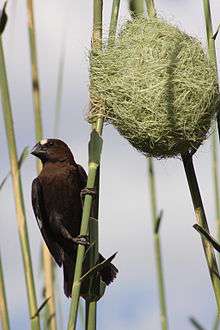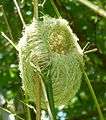Thick-billed weaver
| Thick-billed weaver | |
|---|---|
 | |
| Male in Pretoria, South Africa | |
| Scientific classification | |
| Kingdom: | Animalia |
| Phylum: | Chordata |
| Class: | Aves |
| Order: | Passeriformes |
| Family: | Ploceidae |
| Genus: | Amblyospiza Sundevall, 1850 |
| Species: | A. albifrons |
| Binomial name | |
| Amblyospiza albifrons (Vigors, 1831) | |
The thick-billed weaver or grosbeak weaver (Amblyospiza albifrons) is a distinctive and bold species of weaver bird that is native to the Afrotropics. It is monotypic within the genus Amblyospiza.[2] They have particularly strong mandibles, which are employed to extricate the seeds in nutlets and drupes, and their songs are comparatively unmusical and harsh. Their colonial nests are readily distinguishable from those of other weavers, due to their form and placement, and the fine strands used in their construction.
Range
It has a patchy distribution in West, East and southern Africa,[3] where it is present in marshes, uplands, suburban areas and artificial wetlands.
It is found in Angola, Benin, Botswana, Burundi, Cameroon, CAR, Republic of the Congo, DRC, Ivory Coast, Equatorial Guinea, Ethiopia, Gabon, Ghana, Guinea, Kenya, Liberia, Malawi, Mozambique, Namibia, Nigeria, Rwanda, Senegal, Sierra Leone, Somalia, South Africa, South Sudan, Swaziland, Tanzania, Togo, Uganda, Zambia, and Zimbabwe.[1]
Habitat
Thick-billed weavers breed in reedy wetlands and can be found around forest edge outside the breeding season.[4]
Biology
The thick-billed constructs a distinctive nest which is compact, woven with thin strips of reeds and hung between the upright stems of reeds. It is a globe-shaped nest in which the entrance is placed to the side near the top of the nest. The male weaves the nest with fine material and this makes the nest look neat, but actually the weave is very is not as complex or feveoped as other weaver species. At first the entrance is large, but when a female chooses the nest the entrance reduced to a narrow opening. Thick-billed weaver colonies may involve a single male, or may contain several several males, and is usually established in a reed swamp.[4]
Thick-billed weavers are polygynous, in that a single male attempts to attract and mate with several females. up to six, and three nest may ne active in any male's territory at once. Where they are found at low density there are many apparently monogamous pairs, although they normally nest in small colonies; more than 100 nests in one South African colony. After mating the female normally will lay a clutch of 3 whitish pink eggs, spotted with red, purple and brown. The incubation of the eggs is carried out solely by the female, lasting 14–16 days and the chicks are fed by regurgitation by the female until fledging, although occasionally the male also feeds the young. The chicks fledge after about 18–20 days in the nest. The nests are vulnerable to predation and recorded nest predators include the white-browed coucal Centropus superciliosus, house crow Corvus splendens and the Nile monitor Varanus niloticus. After the nests have been used by the wevaers they may be commandeered by climbing mice, or used for breeding by the zebra waxbill Amandava subflava or brown firefinch Lagonosticta nitidula.[4]
Subspecies
There are five accepted subspecies:[5]
- A. a. capitalba (Bonaparte, 1850) – discontinuously from south eastern Guinea to southern CAR and north western Angola
- A. a. melanota (Heuglin, 1863) – South Sudan and southern Ethiopia, through the rift valley and adjacent lowlands to north western Tanzania
- A. a. montana van Someren, 1921 – Kenyan and Tanzanian interior, south eastern DRC to Malawi and Okavango Basin
- A. a. unicolor (G.A.Fischer & Reichenow, 1878) – East coast littoral from southern Somalia to Zanzibar and Pemba islands.
- A. a. albifrons (Vigors, 1831) – eastern Zimbabwe and central Mozambique, southwards to eastern South Africa
Naming
The generic name Amblyospiza means "blunt, finch", referencing the very large bill,while albifrons refers white forehead of the males. The thick-billed weaver was formally described in 1831 by the Irish zoologist and politician Nicholas Aylward Vigors from the collection of Henry Ellis, the specimens of which were attributed to Algoa Bay and environs in the Eastern Cape.[4]
 Nest built in an exotic bamboo species
Nest built in an exotic bamboo species Female feeding on nettle nutlets in an upland region
Female feeding on nettle nutlets in an upland region_juvenile_(12929741175).jpg) Immature bird showing yellow mandibles
Immature bird showing yellow mandibles
References
- 1 2 BirdLife International (2012). "Amblyospiza albifrons". IUCN Red List of Threatened Species. Version 2013.2. International Union for Conservation of Nature. Retrieved 26 November 2013.
- ↑ "ITIS Report: Amblyospiza". Integrated Taxonomic Information System. Retrieved 14 March 2013.
- ↑ "Amblyospiza albifrons (Thick-billed weaver)". Biodiversity Explorer. Iziko Museums. Retrieved 30 March 2016.
- 1 2 3 4 "Thick-billed Weaver Amblyospiza albifrons". Weaver Watch. ADU - UCT. Retrieved 19 October 2016.
- ↑ "Thick-billed Weaver (Amblyospiza albifrons) - HBW 15, p. 138". Weavers (Ploceidae). The Internet Bird Collection. Retrieved 1 April 2016.
External links
- Thick-billed weaver - Species text in The Atlas of Southern African Birds.
- Thick-billed weaver on Weaver Watch
 Media related to Amblyospiza albifrons at Wikimedia Commons
Media related to Amblyospiza albifrons at Wikimedia Commons
